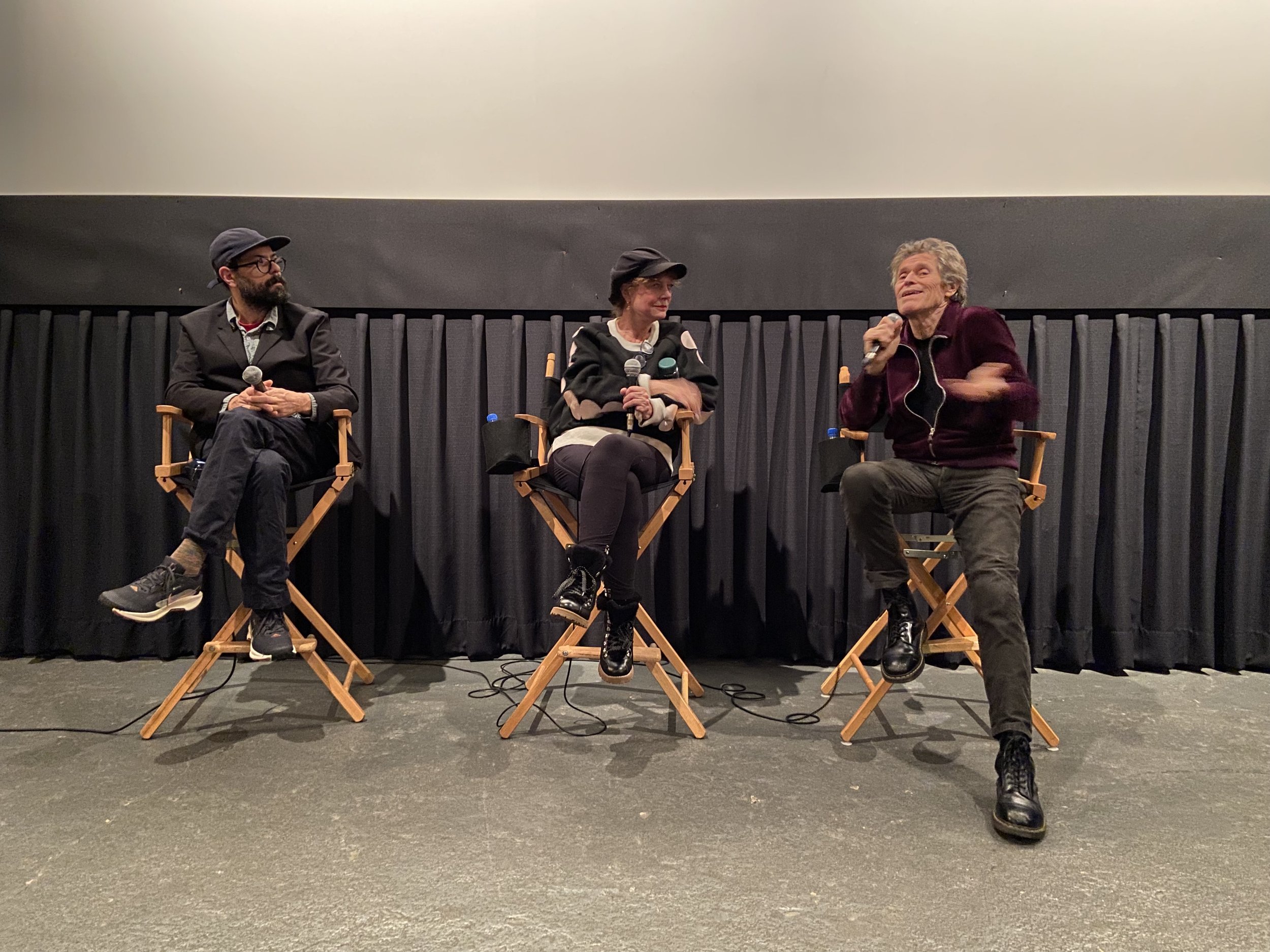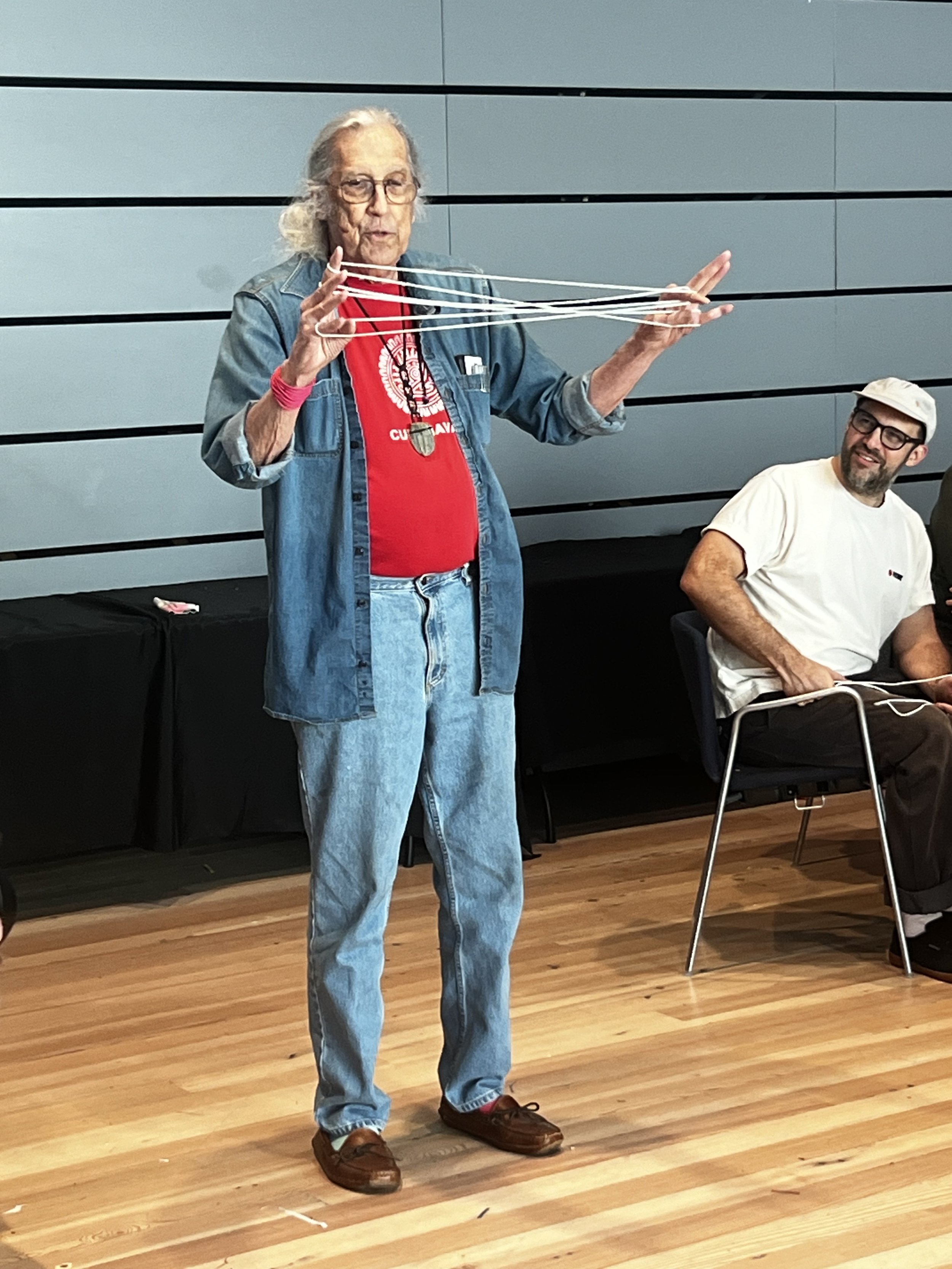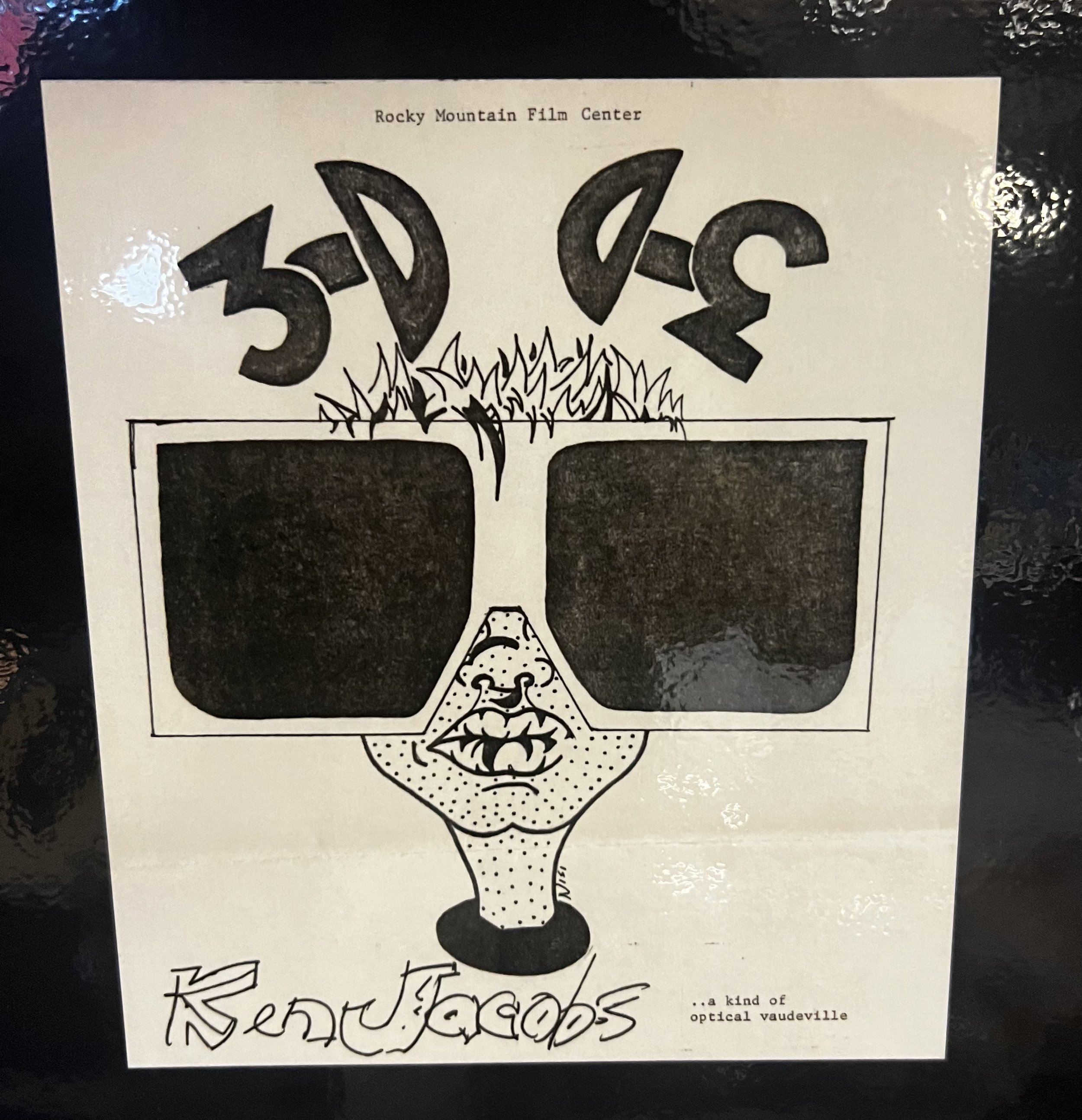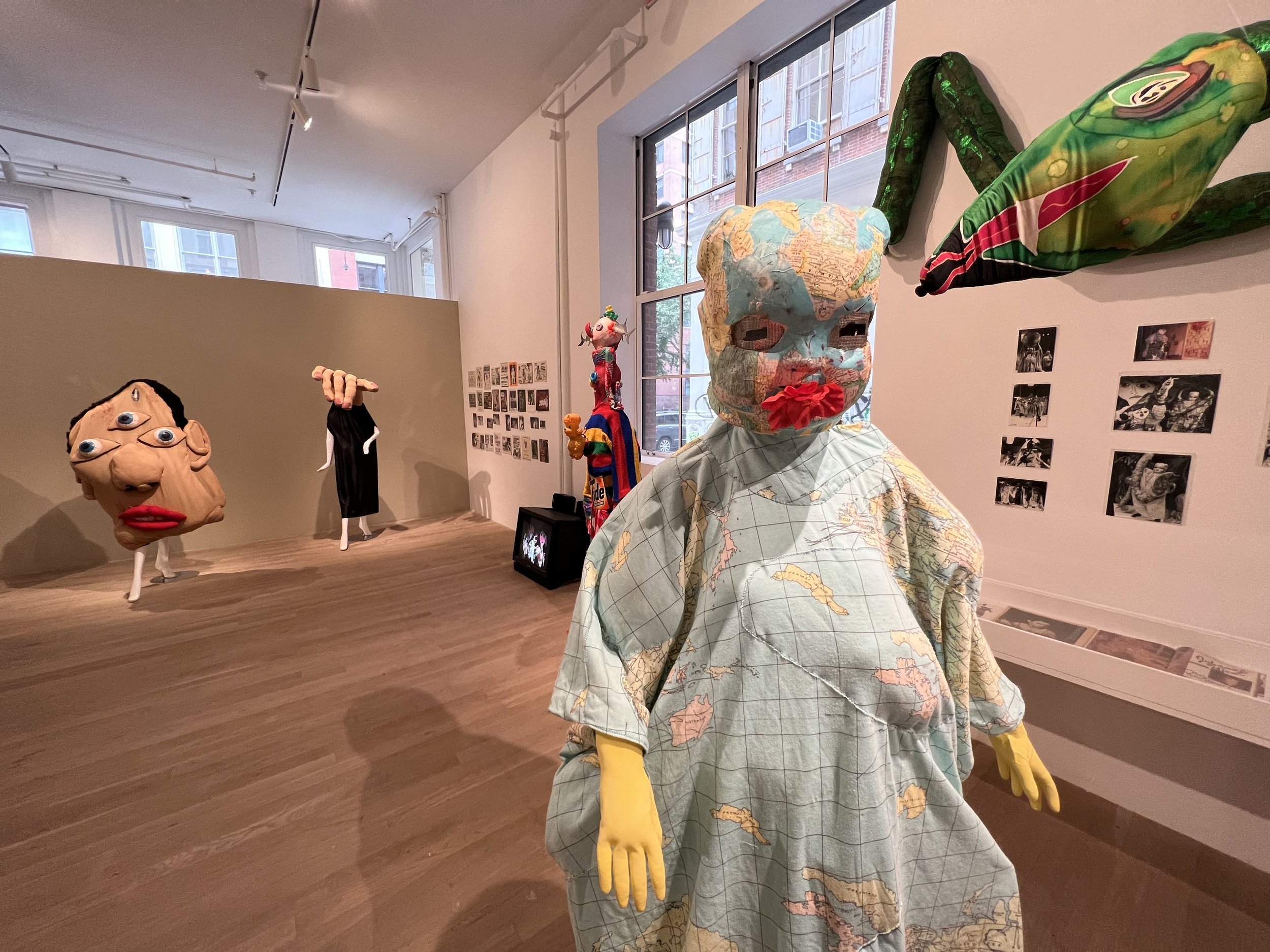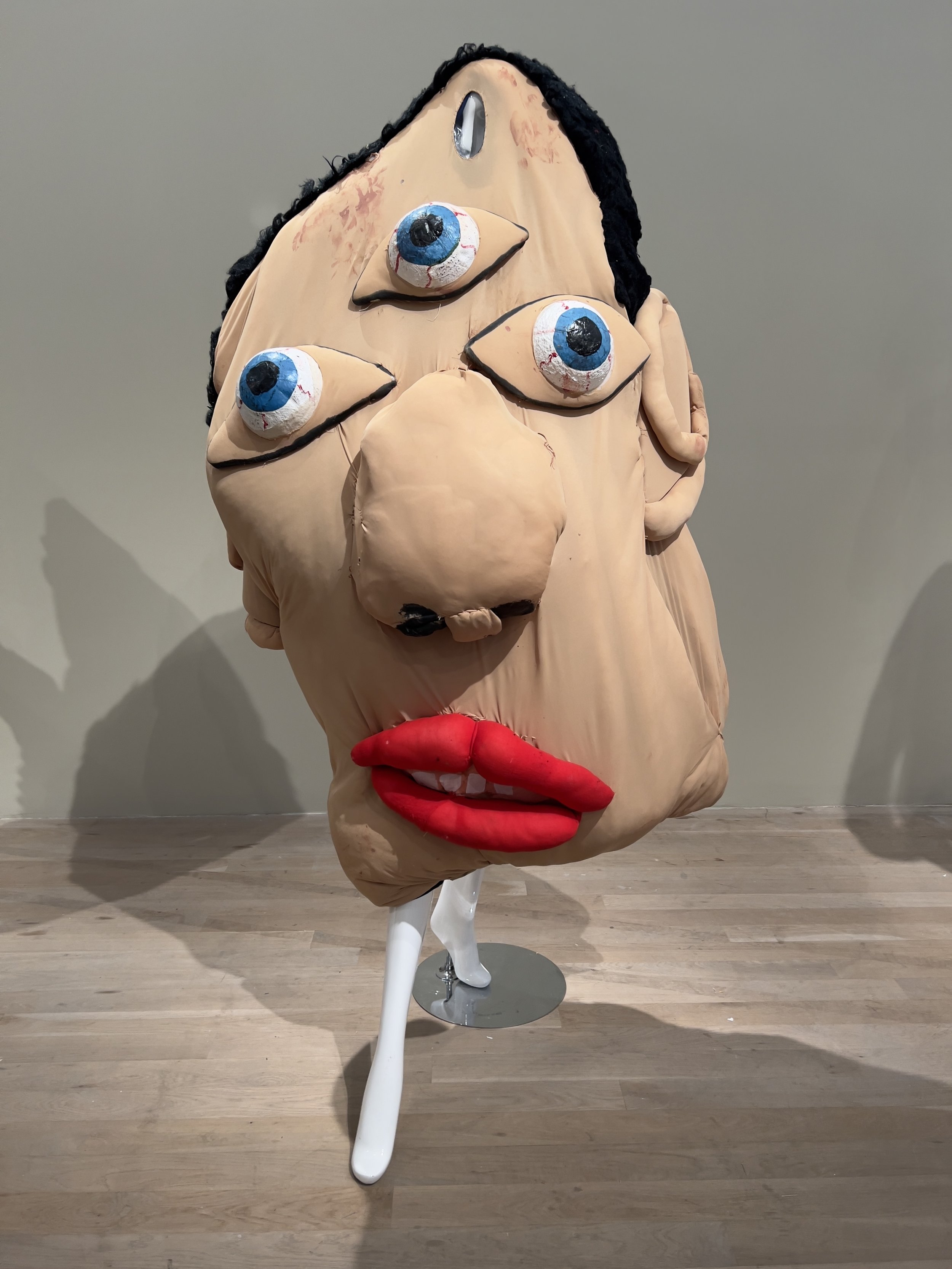Reading @ Flowers Fest 2025
Essex Flowers, NYC
Richard Foreman Film & Video Retrospective /
Astronome by Henry Hills
HIS HEAD WAS A SLEDGEHAMMER: RICHARD FOREMAN IN RETROSPECT
May 21 - 28 @ Anthology Film Archives. Guest-programmed by Andrew Lampert. The retrospective is co-presented by New York University Special Collections, home to the Richard Foreman and Kate Manheim Papers, and The Segal Center Film Festival on Theatre and Performance.
The term “iconoclast” gets thrown around all too much, but in the case of Richard Foreman (1937-2025) there is hardly a more appropriate synonym to describe him. An unparalleled writer and director who ranks among the premier theater artists of the twentieth century, Foreman was also a local legend whose electrifying work greatly shaped the artistic landscape of downtown New York. The founder and director of the Ontological-Hysteric Theater company, Foreman staged eighty-plus astounding plays in a career that spanned over forty-five years, and most of them were presented here in the neighborhood. Foreman’s brazen avant-garde aesthetic was deeply rooted in his early involvement with Jonas Mekas and the 1960s underground film movement. His very first play, Angelface, was performed in 1968 at Mekas’s Film-Makers’ Cinematheque, one of the organizations that preceded Anthology.
This retrospective both memorializes Foreman, who passed away in January, and celebrates the publication of No Title, his posthumous new book just published by The Further Reading Library. Organized in roughly chronological order, the series includes Foreman’s own films and videos alongside an array of performance documentation, documentaries, and portraits. Foreman retired from the theater in 2013 to focus on filmmaking, and the series includes his final digital videos, many of which have never been publicly screened. In addition to this sweeping survey, we are presenting a sidebar program featuring a handful of Foreman’s most cherished films. Some are the movies that inspired him early on, and others are works that he talked about on a regular basis
THE SHAVER MYSTERY @ Light Industry /
May 8, 2025 @ Light Industry
A book launch event for The Further Reading Library and Richard Sharpe Shaver: Some Stones Are Ancient Books. Featuring chapter 5 from the 1935 serial The Phantom Empire starring Gene Autry, The Passion Pot (2003) by George Kuchar, and a reading by Matt Mullican.
Q&A with Willem Dafoe and Susan Sarandon /
I moderated a conversation with Willem Dafoe and Susan Sarandon following a screening of Paul Schrader’s Light Sleeper (1992) at Anthology Film Archives on March 16, 2025.
Richard Foreman Lecture @ NYU /
Artists’ Talk with Jennifer Krasinski and Andrew Lampert
Tuesday, Oct. 1, 2024, 6:30 PM — 8:00 PM
Krasinski and Andrew Lampert will share aspects of their ongoing research into Richard Foreman. Working together, they have uncovered a plethora of documentation and unstaged material that will be featured in a forthcoming exhibition dedicated to Foreman and his collaborators in the Ontological-Hysteric Theater. They will discuss their process and consider the question of what it means to transmit experience. Foreman's iconoclastic productions are largely irreproducible, and yet they must always be performed anew in order to be seen. What is involved in authentically staging the work of a theater artist who insists that others must not interpret or imitate him when performing his plays? Reception to follow.
Co-moderated by Rye Gentleman and Helen Shaw. Co-sponsored by the Department of Performance Studies and the Division of Libraries. Presented as part of NYU's "Archives Onstage" series, Richard Foreman Wants You to Wake Up.
The Hot Seat @ Essex Flowers /
The Hot Seat
with your host Andrew Lampert
Featuring contestants Lindsey and Theo
Live at Essex Flowers
August 25, 2005
Q&A with John McNaughton /
I moderated a Q&A with John Mcnaughton following his documentary Condo Painting at Nitehwawk Propsect Park on September 21, 2024.
Conversation on Jordan Belson /
Jordan Belson: Hidden Formations
Curator Raymond Foye and artist Andrew Lampert join Rail contributor Charles Stein for a conversation.
The Brooklny Rail, New Social Environment #1072
Recorded on Wednesday, May 22, 2024 at 1 p.m. Eastern / 10 a.m. Pacific
Andy Goes Randy: Lampert Interprets Newman /
May 11, 2023
A musical performance of songs by Randy Newman at The Sunview Luncheonette on a shared bill with Invisible Scissors (Rachael Guma and Sarah Halpern)
My Harry @ The Whitney Museum of American Art /
December 8-10, 2023
Whitney Museum of American Art.
I organized a 3-day festival as the public programming component of the exhibition Fragments of a Faith Forgotten: The Art of Harry Smith. Carol Bove, co-curator of the exhibit, and I had a conversation on the first evening.
Paper Airplane contest judge Bradley Eros and contestants
Peter Stampfel
Raymond Foye and Charles Stein
James Inoli Murphy
Living Archive, Living Cinema /
A talk on Ken and Flo Jacobs as part of the symposium
Living Archive, Living Cinema:
Processing the Work of Ken and Flo Jacobs
@ University of Colorado Boulder, Oct. 6 2023
KEN JACOBS: BOOK OF ETERNALISMS @ Corbett Vs. Dempsey /
Ken Jacobs: Book of Eternalisms
March 17 - April 29, 2023
Corbett Vs. Dempsey, Chicago
In celebration of the artist's 90th birthday, Corbett vs. Dempsey excitedly presents a bewildering suite of new works by moving image pioneer Ken Jacobs. A native New Yorker, Jacobs began his artistic career as a painting student of Hans Hofmann in the 1950s, however he quickly concentrated on a more flexible canvas – cinema. A foremost figure in the underground film movement of the 1960s, Jacobs’ decades of restless output include more than forty motion pictures and dozens of expanded cinema performances made with both his self-invented double 16mm “Nervous System” projection apparatus and his nearly indescribable, almost intergalactic “Nervous Magic Lantern.” Since embracing video in 1999, Jacobs has produced well over 150 space-, time-, and perception-bending pieces that transpose his formal and 3D explorations into the digital dimension.
The six-part Book of Eternalisms series from 2022 is composed of the GIF-like digital works that Jacobs has been producing in recent years. Hovering somewhere between street photography and abstract expressionism, these strobing images present once static shots of a Manhattan in perpetual 3D motion. Jacobs writes that: “The word eternalism is meant to suggest a movement in time and deep space -seen without special screens or glasses- that stays, doesn't repeat, but keeps happening and can be seen in illusionary depth by both eyes or a single eye. Decades ago my wife Flo and I got into live projection, which is when we first found the eternalism. There was and is no way to seek it out, or even to imagine it. The eternalism befell us while we were performing with two side by side stop-motion 16 mm projectors. We were investigating close frames on two simultaneously projected prints of the same film, using a spinning shutter upfront to alternate and visually meld the images. The resulting illusion of 3D depth could be recorded and played back, but only after switching to video and digital did the precise construction of eternalisms become possible. The momentary blackness created by the spinning shutter in our film performances is now replaced by an interval of opposite colors on the color wheel. Instead of projecting adjacent film-frames, my videos are based on the left and right frames of a twin-lens stereo still-camera. I hire young people, Antoine Catala and Viktor Timofeev, artists in their own right, to actually create eternalisms on the computer as I look on and make requests. They do the formerly impossible! combining perspectives. Moments! that do not repeat as much as prolong, eternalisms, a name to trip over."
(Andrew Lampert)
This program of Ken Jacobs works has been curated by Andrew Lampert for CvsD
In Conversation with William Wegman in BOMB Magazine /
William Wegman: Art By Artist @ Marc Selwyn Fine Art /
Marc Selwyn Fine Art is pleased to present William Wegman: Art By Artist, a show of drawings, paintings and photographs dating from the early 1970s to the present. This marks Wegman’s fifth exhibition at the gallery. The show is curated by Andrew Lampert, editor of the recent book William Wegman: Writing By Artist (2022, Primary Information).
William Wegman: Art By Artist presents a concise overview of Wegman’s interdisciplinary practice with a special focus on his lifelong passion for art and music. Spanning five decades, the works collectively make visual and verbal art historic references that hearken back to the artist’s irreverent conceptual roots. Among the multitude of subjects are uproarious homages to a vast array of figures from Richard Serra and Josef Hoffman to Frank Sinatra and The Beatles. While the selected pieces bridge multiple eras and mediums, they readily demonstrate the consistent playfulness and signature humorous touch that permeates all of Wegman’s highly diverse output. The show spotlights the artist’s consistently comedic use of writing and language, most especially in his drawings. The title or the work often alters one’s read of the image, or sometimes the title appears within the work itself, acting as a caption or ironic commentary. Either way, Wegman constantly subverts viewer’s expectations by treating word and image as tools to undermine, surprise and induce laughter.
Wegman first gained significant attention as a conceptual artist in Los Angeles at the dawn of the 1970s, and one of the earliest pieces included in the show is the photo Learn To Dance with Modern Electronic Equipment from 1973. The classic photos and videos he created in this period remain revelatory today, but just as surprising and enjoyable are the drawings that he began making that same year. Untitled (1973) shows a wavy music staff that looks like it is dancing to the music, while Cher By Wegman (1975) appears to be just as focused on the artist’s signature as it is on the subject. Homage to 'Albers' (1975) is an unmistakable nod to the Bauhaus master, while Afraid of Yellow (1975) is a possible reference to Willem de Kooning. Classical artists and themes are parodied in vintage 20”x24” Polaroids like Caravaggio (1983), Huddle (2007) and Daisy Nut Ball (1994), a visual twist on Arcimbaldo’s iconic fruit faces. The latter photo features one of Wegman’s famous Weimaraners, who make appearances in a number of other rarely if ever seen large scale Polaroids, including the diptych On and In the Landscape (1988), Underdog (1992) and Framed Portrait (1996).
Wegman returned to painting in 1985 and has since created an expansive body of works that extend his singular vision into dazzling imagistic dimensions. The paintings Gallery Installation (2021) and Paneled Room (2021) are two recent examples of the artists’ remarkable skill and finesse. The latter is a portrait of Philip Guston’s painting The Studio (1969) actually repainted by Wegman but set in a wood paneled room, while the former painting reveals a textural play of different wood boxes that may possibly be shipping crates set up as an art installation. As intricate and striking as they are beautiful and funny, Wegman’s work always possesses a depth that goes far beyond the punchline.
Brooklyn Rail Conversation With Wiliam Wegman Et Al /
June 24, 2022
Artist William Wegman and curator Andrew Lampert join Rail Editor-at-Large Charlotte Kent for a conversation. We conclude with a poetry reading.
SWAN SILVERTONES FOR TWO ROBERT'S: FENZ & HALLER /
Monday, June 20 2022
7:30PM @ Microscope Gallery
525 West 29th Street, 2nd Floor
New York, NY 10001
First presented at the Gene Siskel Film Center in Chicago, IL in 2014, “Other Means” is an audio piece consisting of filmmakers and fellow travelers of Lampert’s talking about the “relevance of cinematic viewing versus the convenience of an iPad and other technologies.” This subject feels particularly timely after the recent closures of cinema theaters and our experience of being forcibly deprived of the theatrical projection.
The new piece “Swan Silvertones for Two Roberts: Haller & Fenz” is a “memorial reprisal” of the artist’s Projector Euthanasia series in which he “cares for” broken and barely working projectors. Lampert feeds them food and liquids, performs minor surgery
and subjects them to other restorative/destructive
actions in in order to provide a swift and painless passing.
ATTENTION LINE @ Artists Space /
Attention Line
June 11 – August 20 2022
Blaster Al Ackerman, Craig Baldwin, Ed Bereal: Wanted for Disturbing the Peace, Circus Amok and Jennifer Miller, Vaginal Davis, Manuel DeLanda, James Luna, Tom Murrin (aka The Alien Comic), Tamio Shiraishi, Hannah Weiner, and Johanna Went.
Organized by Artists Space and Andrew Lampert, Attention Line considers the important ways that artists who generally operate outside the commercial confines of the visual art world can actively address and reconfigure media, power, and public space—through parody, exaggeration, confrontation, internalization, structured confusion, and the serendipitous nature of working out in the open. Rooted in late 1970s New York, San Francisco, Los Angeles, Baltimore, San Antonio, Portland, La Jolla and elsewhere in the United States, Attention Line presents eleven iconoclastic artists who self-reflexively enact radical subjectivity within the urban environment. Taking form as visual art, media interventions, stage shows, mail art, and surreptitious public performances, these artists disrupt communication channels and the trafficking of cultural material by intervening in the pervasive flows of normalcy that underpin and uphold everyday consumer culture.
Each of these remarkably singular artists has carved out their own dynamic relation between form, culture, and their suspecting or unsuspecting public. Whether working between covert urban intervention and filmed documentation (Craig Baldwin and Manuel DeLanda), exaggerating and embodying notably troubled cultural stereotypes (James Luna and Vaginal Davis), accelerating and fracturing the commonplace logic of live performance to imbue material culture with energetic chaos (Johanna Went and Tom Murrin), skewering political and hegemonic power with dark comedic parody (Ed Bereal and Circus Amok), expressing their internal subjectivity as disjunctive projections in urban space (Hannah Weiner and Tamio Shiraishi), or self-distributing their kaleidoscopic output and invented personae through decidedly unconventional means (Blaster Al Ackerman and others), these artists each bring forth critical aspects of a largely untold, uniquely American history of tactical situationist artmaking.
Improvising saxophonist Tamio Shiraishi will perform in Cortlandt Alley six times throughout the course of the exhibition. Performances will begin promptly and be brief, according to the following schedule:
Saturday, June 11, 6:30pm
Thursday, June 23, 6:30pm
Saturday, July 2, 1pm
Saturday, July 16, 1pm
Thursday, August 4, 6:30pm
Saturday, August 20, 1pm
New York’s legendary Circus Amok will present a new outdoor circus performance in Cortlandt Alley, commissioned by Artists Space as part of Attention Line.
Saturday, August 13, 2pm
William Wegman: Writing By Artist @ Sperone Westwater /
Sperone Westwater is pleased to present William Wegman: Writing by Artist, a show of texts, drawings, paintings, early photographs, and videos by the artist dating from the early 1970s to the present, many shown here for the first time. This solo marks Wegman’s seventh at the gallery and coincides with Primary Information’s book of the same name, edited by exhibition curator Andrew Lampert and published in April 2022.
Installed on two floors of the gallery, Writing by Artist offers a wide range of entry points into the artist’s universe. Spanning five decades, the works in this exhibition all hinge conceptually and pictorially on writing and language, including games, puns, and palindromes—incorporating words in one form or another. In some instances, the text is simply a caption or a few handwritten words. In others, prose delightfully unravels in surprising forms—Wegman types absurd non-sequiturs on Princess Cruises stationary, witty annotations are scribbled onto a curator’s essay, and words are deliberately mistranslated, reworked, and fictionalized in graphite and ink on paper. The works are installed in thematic groupings such as architecture/houses, furniture, history, language, perception/multiplicity, relationships, time/calculations, and television/media.
Featured also are the artist’s early photographic works, dating back to the three years he lived in Los Angeles from 1970 to 1973. During this time, Wegman became closely associated with such artists as Ed Ruscha, John Baldessari, and Allen Ruppersberg, with whom he shared both a sense of irreverence towards conceptual art and, more importantly, a sense of humor. Poking holes in the stuffier, more academic, East Coast version of conceptualism, Wegman and his LA colleagues used paint, drawing, video, and photography in ironic ways, often paired with language, to turn didactic formalism on its head. Turning away from handcrafting objects, Wegman utilized domestic, readymade props and banal subjects close at hand. He sometimes used video to improvise short performances— staged vignettes in which expectations are reversed, and puns and homonyms are pursued to absurd conclusions. In one 1972 photograph, the artist is seen jumping away from a pile of his clothes, scattered nearby on the studio floor. The accompanying type transforms the scene: “For a moment, he forgot where he was and jumped into the ocean.”
William Wegman: Writing by Artist will be on view from 5 May – 29 July 2022. An opening reception will be held at the gallery on Thursday, 5 May from 5 to 7pm.
Wegman Book Launch @ Topos /
Sweethearts (Twice for Emmet Williams, Now For Enrico Camporesi) @ Centre Pompidou /
Wednesday, April 20 2022
Centre Pompidou, Paris
A new version of SWEETHEARTS (For Emmet Williams), an old piece, tightened and more timely, revised for the present moment. Featuring Kendra Walker and Stefano Canapa.
Presented as part of the series TYPO FILM curated by Enrico Camporesi.
Screened alongside the Japanese subtitled version of EL ADIOS LARGOS (2014) and works by Len Lye, Yann Beauvais, George Landow and Paul Sharits.


